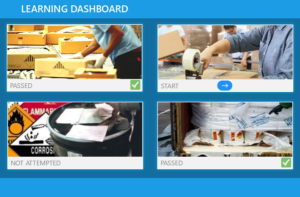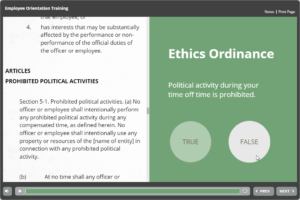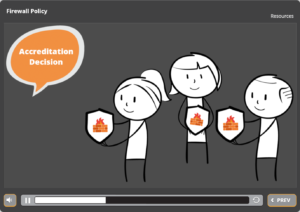Share this article:
For six years now, ThinkingKap has been speaking at the Chicago eLearning and Technology Showcase, and this year was no different. In addition to the TK booth we had set up, we presented two separate sessions: Fun Compliance Training – More Than Just Checking The Box and Maximize eLearning Engagement by Converting Narration Scripts into Interactive Dialog. Both sessions went really well with some great dialog and some unique twists on our examples presented by attendees. We also highlighted some effective training engagement techniques.
Fun Compliance Training – More Than Just Checking The Box
If you’ve ever designed a compliance course, you’ve surely run in to the fact that they typically aren’t the most riveting courses ever developed. Often, the stakeholders for these courses are just looking to “check the box” that everyone has viewed the material, and that’s good enough. BUT IS IT?
Admittedly, there are rare instances where the ONLY objective a company has is to adhere to some regulation that their employees have completed a required course. If the company sees no educational merit in employees learning the information, then checking the box can be the most cost effective way to go about things. However, in most cases, compliance training is ultimately about people adhering to certain rules or policies, which they would ideally…actually know. I mean, how can they properly adhere to rules in all the right situations if they don’t know how the rules apply? This is where most compliance training falls WAY, WAY short.
So, our session focused on ways to make compliance training fun (probably more accurate to say engaging) to assist in the users actually learning and being able to apply the information within the course. We presented 10 different engagement techniques, spread across 10 real-world eLearning examples. We’ll highlight those examples here, and may even revisit them in more detail with an upcoming blog post, or potentially a future free webinar.
Hazardous Material Handling

TECHNIQUE 10: Compliance Test-Out
Not a new concept, but allowing learners to test out of material they already know motivates them. They realize that they won’t be dragged through topics they’re already familiar with. And for management, they reduce the amount of learner seat time for those that know the content, meaning they can get back to work.
Employee Onboarding

TECHNIQUE 9: Policy Look-Up
Typical onboarding training has employees sign that they have reviewed the policies, but seriously…does ANYONE? In many cases, it isn’t realistic for them to memorize the policies, but more so to be able to access them when needed to reference against a current situation. As referenced in a prior post, by embedding the policy into the course, and asking realistic scenario questions, the learner is faced with the real task of using the policy to determine if the expressed behavior is compliant or not.
Travel Safety

TECHNIQUE 8: Game-like Reality
Too often, people taking compliance courses feel like the material is not relevant to them. We addressed this by creating a game-like intro to the course, where users answered “have you ever…” type questions, and then were scored to show them how risky of a traveler they are based on their own behaviors.
TECHNIQUE 7: Dream Sequence Stories
The client wanted a balance between demonstrating the serious risks involved with traveling (especially abroad) without making people too scared to travel. We accomplished this by creating “dream sequences” where the narrator recounted one of his many faux pas related to travel, and the negative impact it had on his trip.
HIPAA Privacy Compliance

TECHNIQUE 6: Visual Knowledge Checks
With some questions, once you put them into a basic multiple choice format, the correct answers are pretty obvious. So, to address this, and to ground the course within the employee’s environment, we created a “find the violation” style knowledge check in the form of a game. We took photos of people’s actual desks with various (staged) HIPAA violations. Things like a computer being unlocked while unattended, or forms with patient info left out after hours. Learners were then tasked with identifying the violations, which was much more practical than asking questions with correct answers like “don’t forget to lock your computer.”
TECHNIQUE 5: Humorous Stories
We dug this course out of the archives because it was one of the better examples of this technique, or so said the Articulate GURU judges. What could be more boring than HIPAA Privacy, right? Well, we encased the course within a story that drew people in right from the beginning. A ton of compliance training is about mitigating risks, so base the course around some of those risks, and you have yourself a compelling story.
Firewall Compliance Training

TECHNIQUE 4: Expert Personalities / Avatars
Within this client, everyone turned to a single person as the “face” of their firewall policy. She wanted to detach herself from being the only place people turned for firewall info, so we created a new face. The firewall course used our VR Conversations (Virtually Real Conversations) technique to bring the narrator to life. She not only portrayed expertise of the subject matter, but did so with such personality that learners fell in love with her.
TECHNIQUE 3: Random Test Bank for Uniqueness
Some topics are evergreen, so how do you make the course that way as well? One way to keep a course relevant and challenging for multiple cycles is to create large test banks for the knowledge checks and quizzes, so every year, when users re-take the course, they are presented with new challenges (and the learners can’t compare questions / answers to cheat).
TECHNIQUE 2: Audience Adaptation / Personalization
Part of what made this course so special was how it adapted to learner requirements. The entire second half of the course was full of detailed scenario questions. However, to avoid forcing everyone through scenarios that weren’t relevant, the course interviewed each user and then recommended only those scenarios that were related to tasks that person performed. Using our VR Conversations strategy, the narrator remembered all of the users answers, so she could collect information about their jobs and then provide each user with a customized scenario list based on what she felt was most applicable.
TECHNIQUE 1: Interactive / Personalized Dialog
This techniques is really the heart and soul of the VR Conversations strategy. It presents a course that’s typically a monologue (narrator talking at the learner) in a way that draws the learner into a conversation with the narrator. This style not only gives personality to the narrator, but creates a tremendous amount of engagement for the learner. They get the illusion that the narrator is really there with them, tailoring the course to their needs, rather than pushing them down the same “one course fits all” track as everyone else.
Maximize eLearning Engagement by Converting Narration Scripts into Interactive Dialog

Both sessions went great, but apparently this one was a real hit. We played off the Firewall Compliance course discussed above, and went into detail about our VR Conversations technique. This included how we created it, how you go about producing the illusion of a two-way conversation in an eLearning course, and generally how to bring the narrator to life. In fact, the session was so popular that we’re considering doing future webinar workshops on creating these, so stay tuned, and let us know if it’s something you’d be interested in.
Next month we’ll start our ongoing series of posts looking at individual case studies. Each month, we’ll focus on one case study from two different perspectives: one post will look at a design or development aspect that IDs or developers could take away from the project, the other post will focus more at the program level and discuss some of the strategic take-aways.

About
Tim Buteyn
Tim Buteyn, President of ThinkingKap Learning Solutions, has been in the training and instructional design field for almost 20 years. He founded the company because of his passion for creating engaging learning experiences. Adult learning theory, instructional design, innovative instructional strategies, and accelerated learning concepts have driven him to create ThinkingKap Learning Solutions.